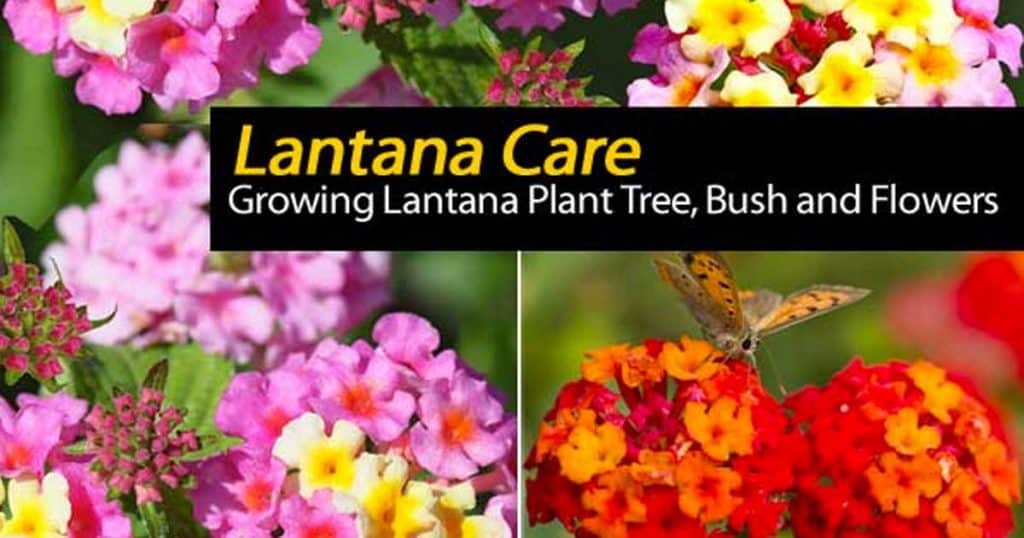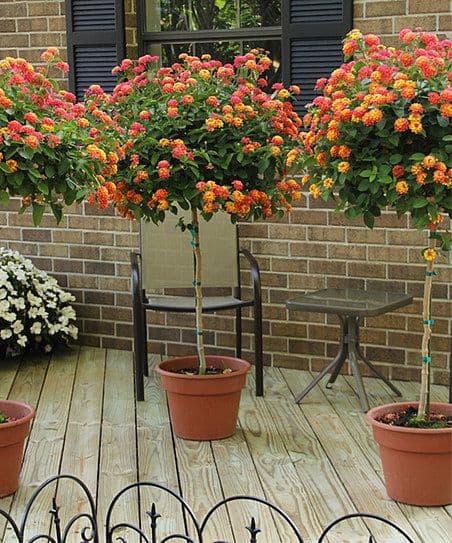The lantana plant is a bright, full sun-loving plant. It produces yellow flowers in abundance on a long stalk and rewards you with lots of flower colors.

Mastering lantana care is not difficult. Lantana is a tropical plant made to order for any bright patio with lots of direct full sun. Lantana plants are tropical plants requiring lots of warmth.
Lantana Plants Verbena Relatives
The Lantana genus has over 150 species and belongs to the Verbena family (Verbenaceae).
They grow much taller than the well-known annual verbena, but the small clusters of tubular blooms on this perennial flowering plant look similar and bloom as freely.
The Lantana flower color comes in red, orange, yellow, white, pink, and lavender.
Lantana’s care requirements are somewhat different than those of verbena, and they live in different environmental settings. These plants hail from tropical areas in Africa and the Americas.
However, they have been introduced to many warm climates worldwide, especially in the Pacific regions, Australia, and many parts of India.
Lantana Plants Quick Care Tips
- Botanical Name: Lantana camara
- Common Name(s): Lantana Bush, Shrub Verbena
- Synonyms: Red Sage, Wild Sage, Yellow Sage
- Family & Origin: Verbenaceae family, native to tropical regions of the Americas and Africa
- Growability: Easy to grow
- Grow Zone: USDA zones 8-11
- Size: Grows up to 6 feet tall and wide
- Flowering: Blooms in clusters of small, brightly colored flowers from spring to fall
- Light: Full sun to partial shade
- Humidity: Tolerates low humidity
- Temperature: Tolerates a range of temperatures, but prefers warm climates
- Soil: Well-draining soil
- Water: Water regularly, but do not overwater
- Fertilizer: Fertilize every 2-3 months with a balanced fertilizer
- Pests & Diseases: Susceptible to spider mites, whiteflies, and powdery mildew
- Propagation: Propagate through stem cuttings or by seed
- Plant Uses: Used as a decorative plant in gardens and landscapes, attracts butterflies and hummingbirds, and has medicinal properties in some cultures.
How To Care For Lantana
Size & Growth: How Big Do Lantana Plants Get?
All cultivars of these perennial plants grow pretty quickly, and some Lantana varieties (e.g., Miss Huff) are very vigorous growers.
Most can tolerate rather aggressive pruning to prevent them from becoming overwhelming.
Lantana leaves are rather coarse and slightly prickly. In addition, it is very rough to the touch.
When crushed, the leaves of most types of Lantana have a strong, pungent scent. For this reason, avoid growing Lantana to line walkways.
Garden centers begin stocking plants in late spring. Planting outdoors depends on the weather since lantana plants grow best in frost-free climates.
The previously recorded video gives you some ideas of what a Lantana tree can look like!
Lantana Flower & Fragrance
Perennial Lantana thrives in very hot climates, where they produce mass quantities of flat-topped clusters of showy flowers all year round from midsummer until the first frost.
The blooms of Lantana plants come in a wide variety of colors. The broad, disk-shaped flower clusters are extremely attractive to hummingbirds, butterflies, and other pollinators.
If you grow Lantana in excessive shade, you are likely to impair flower production. Too much fertilizer will also hinder blooming.
If you allow your Lantana plant to set berries, blooming will diminish. To encourage more blooming, cut your plants back, and deadhead old blooms to stimulate new blooms.
Related: Why Do Lantana Flowers Change Colors
Lantana Light & Temperature Requirements
Lantana plants thrive in full direct sunlight and can be grown as a perennial in any sunny setting that doesn’t get extremely cold. In areas that experience hard frost, grown Lantana as an annual plant.
In warmer climates where frost seldom, if ever, occurs, grow Lantana grows all year in the garden.
Lantana is typically winter hardy in USDA hardiness zones 9 through 11. However, in colder climates like USDA hardiness zone 8, the plant may die back to the ground in winter and grow from the roots in spring.
Even in settings where the temperature may drop to 20° degrees Fahrenheit, the plant can survive from year to year as long as the roots do not freeze.

How Much Water Do Lantanas Need and When Should Lantana Be Fertilized?
Immediately after planting Lantana, water thoroughly and keep the soil moist for a couple of weeks until the plant has become established and you see new growth.
Once established, you will find Lantana to be durable and drought tolerant. Lantana grows, blooms, and flourishes even in hot, dry settings.
Treat established plants as wildflowers. But when the plant is blooming, water deeply once weekly.
Sandy soil will require additional watering. Avoid overhead watering. Instead, deeply soak the ground around the plants.
Because these tropical plants are practically wildflowers, they require very little fertilizer. Therefore, in early spring, provide a light-balanced fertilizer.
If your plants are growing quite vigorously and producing lots of colorful flowers, you may wish to fertilize again in the middle of the summer.
Be careful not to over-fertilize, as this will reduce blooming and cause your plants to become more susceptible to disease. Heavy feeding can cause leaf yellowing and premature leaf drop.
Lantana Soil Conditions & Transplanting
Lantana can do quite well in areas with poor soil as long as they are planted in well-draining soil. These plants prefer slightly acidic soil in a dry setting and develop root rot in moist soil conditions.
Plant Lantana in the springtime, a couple of weeks after all danger of frost has passed. Lantana is grown as a perennial in areas where it will not begin its spring growth until the air and soil temperatures are consistently warm.
It likes to grow in warm, well-drained soil. When growing Lantana in pots, use high-quality potting soil that drains well.
When buying plants at your garden center, look for bushy plants with stiff stems and lots of buds.
Lantana Care Grooming & Maintenance
Regular light pruning controls growth throughout the plant’s growing season and encourages branching and blooming.
Very energetic older plants may become excessively large and outgrow their space.
When this happens, don’t be afraid of vigorous pruning. You can cut back the woody stems to about a third of the plants’ spread and height without causing any damage.
After pruning, provide deep watering and a little fertilizer to encourage blooming.

Prune vigorously in early spring to clear away old, dead growth and provide space for new growth.
You can cut the plant down to about 6″ inches high without worry. In the autumn, do not prune harshly because this will reduce the plant’s ability to withstand the cold.
Other Lantana Plants
- Lantana Montevidensis (trailing Lantana)
- Lantana Trifolia (popcorn Lantana)
- Lantana Horrida
How To Propagate Lantana
Lantana is incredibly easy to grow from seeds or cuttings. If growing from seed, soak them first in warm water and follow packaging directions for your area.
If growing from cuttings, follow the handy advice in our article Propagating Lantana Plants.
Lantana Problems – Common Pests or Diseases
Lantana is a very low-maintenance plant and is not generally susceptible to pests and diseases as long as ideal conditions are maintained.
It’s also deer resistant due to its fragrance.
However, a handful of pests can impact the plant. Proper cultural practices limit most attacks. In addition, early detection and pest identification will speed up treatment and the recovery process.
Aphids – are generally found around the growing tip, buds, and undersides of leaves, where aphids suck sap from the plant and excrete a sticky substance called honeydew.
Lantana plants heavily infested experience yellowing leaves, leaf drops, leaf curling, and wilting. Check out this post for getting rid of aphids naturally.
Whiteflies – Small, white insects located on leaf undersides. Both adults and young feed on the plant.
Severe infestation causes leaf drops beginning with yellow leaf spots. Control with horticultural oil, insecticidal soap, or another natural organic insecticide neem spray oil.
Spider Mites – severe infestation during hot, dry periods. Spider mites hide on the undersides of leaves.
Look for plants lacking vigor, leaves showing a yellow-to-gray cast, and leaf drops. Read more on How to kill spider mites.
Lantana Lace Bug – widespread pest feeds on the undersides of leaves. Populations of lace bugs multiply with high temperatures (90 degrees Fahrenheit).
On heavily infested plants, leaves turn yellow and fall off early. Prune out severely damaged areas, and treat them with a systemic insecticide like acephate or imidacloprid. Provide sufficient nutrients and water to ensure recovery.
Leaf Miner – Feeds on interior leaves, leaving a whitish trail. Plants can handle a fair amount of injury before plant health comes into question.
Prune and destroy infested branches and foliage. In some areas, parasitic wasps help control pests populations. Control with horticultural oil, insecticidal soap, and other insecticides.
Mealybugs – Mealybugs “hide” on the undersides of leaves and stems, with damage similar to aphids.
Treat small outbreaks with a 50-50 spray of water and isopropyl alcohol. For more extensive infestations, control with horticultural oil, insecticidal soap, and other insecticides.
Powdery Mildew – A common fungus plant disease, causing leaf yellowing and feeding on plant nutrients. Powdery mildew spreads rapidly. Most common on upper leaf surfaces.
Prune or thin plants to encourage good air circulation, and water plants from below to keep foliage dry.
Lantana growing in the shade may be susceptible to problems with the following:
- White Fly Infestation
- Powdery Mildew
- Sooty Mold
You can expect root rot if you plant it in a poorly draining potting mix or water too often.
Is Lantana Considered Toxic or Poisonous to People, Kids, and Pets?
For the complete details, check out this article: Is The Lantana Plant Poisonous Or Toxic? The Answer!
Some Lantana cultivars produce bluish-black, fleshy fruit. This can be toxic, especially if a great deal of it is eaten.
Contact with its unripe, green berries and leaves can often cause minor skin irritation too.
If you are concerned about pets, kids, livestock, or birds consuming the fruit, you should choose a sterile cultivar such as:
- Patriot Deen Day Smith
- Patriot Marc Cathey
- Weeping Lavender
- Weeping White
- Lemon Swirl
- Miss Huff
- New Gold
- Samantha
- Mozelle
Sterile varieties don’t produce seeds or berries and tend to bloom reliably throughout the growing season.
Is Lantana Invasive?
Lantana does well in harsh conditions and can flourish in very dry settings with very poor soil. They also can become an incredibly invasive species.
Many types of Lantana species are considered invasive in:
- Australia
- Florida
- Hawaii
- Texas
Be careful not to allow your Lantana plants to get out of control. Prune it regularly and take care not to let the roots spread beyond your garden.
How to identify NATIVE Lantana vs. INVASIVE Lantana camera?
Suggested Lantana Plant Uses
Many Lantana varieties are used for a wide variety of purposes in the garden. For example, depending upon the type of Lantana you choose, you can use this hardy ornamental plant as a:
- Hanging baskets
- Garden ornamental
- Good houseplant
- Ground cover
- Hedge
- Border shrubs
- Specimen plants
- Potted Lantana Tree
- Use Lantana to attract butterflies, bees, and hummingbirds to a Butterfly garden
They also make an excellent choice for erosion control on slopes.

Some types of Lantana can grow to be 6′ feet high. They may form huge, bushy mounds. Still, other types ramble and spread as a low-growing groundcover.
Still, others only grow as fairly small, easily controlled plants.
The common Lantana is a good choice for beach house shrub planting because it is rather salt tolerant.
Family: Verbenaceae
Common Name: Weeping, Trailing Lantana

